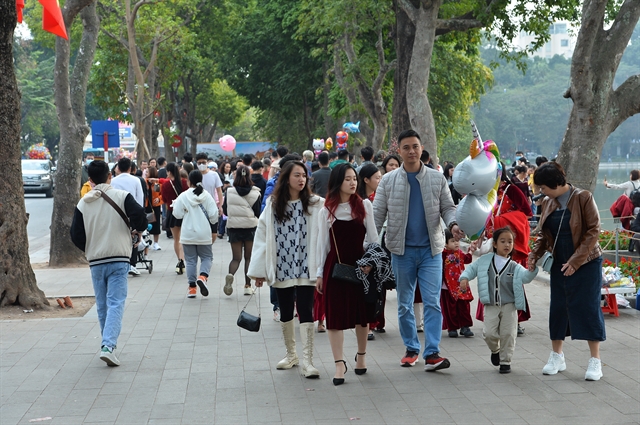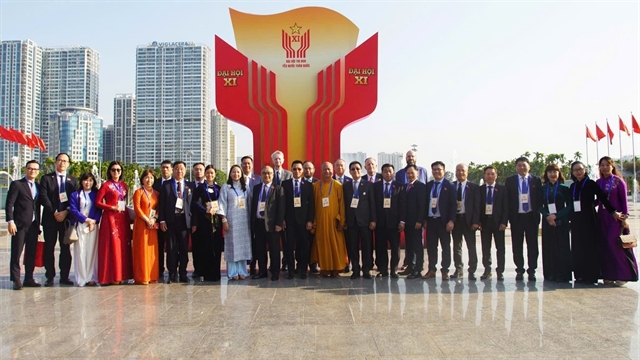 Society
Society

The large population and abundant workforce mean an attraction for foreign investors, but pose problems of food and energy security.

|
| People take a walk in the Hoàn Kiếm pedestrian area in Hà Nội during the 2023 Lunar New Year holiday. — VNA/VNS Photo Minh Đức |
HÀ NỘI — Việt Nam is about to welcome the 100 millionth citizen, 10 years after its population hit 90 million in 2013.
With this milestone, Việt Nam becomes one of the 15th most populous countries in the world.
As of the end of 2022, Việt Nam’s economic scale and per capita income reached US$409 billion and $4,110, respectively. Such figures are expected to hit $424.45 billion (forecast by international organisations) and $4,400 (a target set by the National Assembly) at the end of this year.
When the population hits 100 million, the economic scale must be over $440 billion. This means that GDP growth must exceed the threshold of 7 per cent in 2023.
100 million hopes
According to the United Nations Population Fund (UNFTA), the world is changing at a rapid pace, and Việt Nam should not fall behind. Having 100 million population would mean a sizable domestic market, possibilities to attract more foreign direct investment with the availability of healthy, well-educated and skilled labour force, innovative and creative minds, and strong dynamism in the country.
Therefore, it is critical to be aware that 100 million in 2023 is not merely a number. It comes with a need for a vision of building a strong Việt Nam for today’s and for tomorrow’s generations, as the population represents “100 million hopes, 100 million dreams, and 100 million possibilities.”
Professor Nguyễn Đình Cử, president of the scientific council of the research institute for population, family and children, said that if the 100 million people are placed in the context of economic development and high intellectual level, it will be a great opportunity for development.
Việt Nam is a large, populous market with a sizeable workforce (with more than 50 million labourers), so it has favourable conditions to develop a multi-sector economy, he said.
The large population and abundant workforce is an attraction for foreign investors, he said, adding that 100 million people, however, pose problems of food and energy security.
Given such issues as low area per capita and climate change, ensuring quality education, health care and environmental protection for 100 million people will not be a simple problem, Cử pointed out.
The UNFPA noted that the challenge is that as mortality and fertility decline, Việt Nam will soon complete the demographic transition. It is a significant achievement that in today’s Việt Nam, people are healthier and live longer. But with fertility decline and limitation over the past decades, Việt Nam’s population is aging fast.
Capitalising on labour quality
According to the General Statistics Office, the 100 million population will serve as a solid resource for socioeconomic growth and an opportunity for rapid and sustainable development of the country. Moreover, Việt Nam is in a period of golden population structure, with nearly 70 per cent of the population being in the working age.
Phạm Trọng Nghĩa, full-time member of the National Assembly's Committee for Social Affairs, said Việt Nam has a strong labour force of 51.5 million people, ranking third in the ASEAN region. The quality of labour remains low, with the rate of trained workers being only 67 per cent and of those with diplomas and certificates just 27 per cent, he noted.
“If we do not have policies to take advantage of opportunities and promote strengths brought about by the period, this will be a huge waste, resulting in multifaceted negative impacts that may last for many generations,” said the deputy.
Việt Nam’s golden population rate is expected to end in 2038. According to demographic rules, such an end marks a transition to the period of aging population. Therefore, it is necessary to maximise the advantages of the current abundant workforce to serve socio-economic development and accumulate resources to cope with the future increase in the proportion of older persons.
According to Nghĩa, if the golden population coincides with a period of economic stability and education that offers workers knowledge and professional skills, it will become a strong driving force, promoting socio-economic development. On the contrary, without appropriate policies, the country will encounter such challenges such as under-employment, the middle-income trap, increasing social vibes, which are a burden hindering growth in the long run.
The UNFPA advises that Việt Nam continue to invest in young people through its policies and programmes on health, education, and employment opportunities, so as to meet the needs of the labour market in the new era and stimulate innovation in the country. It is also critical to strengthen policies on health-related services, including sexual and reproductive health. — VNS




